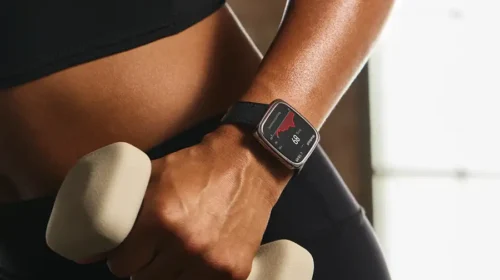Zepp hits its stride with return to revenue growth

The maker of low-end wearable devices reported its revenue rose 78.5% in the third quarter, but forecast the rate would ease to about 40% in the current quarter
Key Takeaways:
- Zepp Health reported a second consecutive quarter of strong revenue growth in the three months to September, as it achieved breakeven on an adjusted operating basis
- The maker of fitness wearables is inching back towards profitability after ditching its former reliance on Xiaomi to develop its own Amazfit brand
By Doug Young
Meme stock or serious player in the global wearables market?
That’s the big question hanging over Zepp Health Corp. (ZEPP.US), whose stock has soared by more than 10 times since July as investors discovered the company in the bargain bin of the global market for wearable fitness devices. Zepp announced its latest quarterly results on Tuesday, which included very strong revenue growth as its Amazfit-brand products found a comfortable place at the low end of the market.
While some might argue the company’s stock run-up of the last four months looks highly speculative, akin to the GameStop (GME.US) meme-stock phenomenon of 2021, the big share gain in this case looks more sustainable in our view. Here, we should also point out that the stock has actually lost 40% of its value from a multi-year peak in September.
Even after all those ups and downs, Zepp’s stock still trades at a relatively modest price-to-sales (P/S) ratio of just 3.98. That’s just over half the 7.39 ratio for Garmin (GMIN.US), Zepp’s only major publicly traded competitor. That seems to show that the recent run-up is more a reflection of the fact that Zepp was previously extremely undervalued, and that the stock is just now being discovered by investors.
Interestingly, the stock has yet to be discovered by the analyst community. Only one analyst polled by Yahoo Finance covers the company, and participants on its latest earnings call were all from small houses with names like Fundamental Research Corp. and Point72 HK. We expect that could change next year, since there really aren’t too many standalone options from this fast-growing segment of the electronic gadget market.
Zepp is quickly gaining traction in that market, though its reputation could use some work. It’s known for its fitness trackers that contain many of the same functions as their rivals, though at far lower prices. The most recent of those is the company’s Amazfit T-Rex 3 Pro, whose September release was a highlight for the third quarter. The device sells for $300 on Amazon, far less than a comparable product from Garmin selling for $1,100. And Amazon reviewers generally rate it pretty highly.
But as the saying goes, “You get what you pay for,” which is reflected in a review for the T-Rex 3 Pro in the authoritative Wired magazine. “Virtually every screen, every quest to change settings, every attempt to do even more (than) the most rudimentary thing left me wanting to tear my hair out,” the reviewer wrote. “It’s almost impressive how bad it is.”
Clearly Zepp has some work to do to make its products more competitive with the likes of Garmin and Fitbit in terms of user-friendliness. But for now, at least, its low-cost strategy is turbocharging the company’s revenue, which only returned to growth in this year’s second quarter. Equally important, the company has returned to positive cash flow, and is inching closer to a return to profitability after years of losses.
Xiaomi separation
The current Zepp, in many ways, represents the second life for a Chinese company that got its start mainly as a maker of wearables for smartphone giant Xiaomi (1810.HK) under a licensing agreement. But the company quickly realized such business was very low margin, not to mention dependent on a relationship that could easily change if Xiaomi decided to terminate the agreement or license other wearables partners as well.
Over the last few years the company has mostly weaned itself from Xiaomi products, which now account for just around 5% of its total sales. That weaning process was quite painful, leading to sharp revenue declines and a plunge into the red.
Zepp finally returned to revenue growth in a big way in the quarter through June, when the figure jumped 46.2% year-on-year on new product launches that received generally positive reviews. That growth accelerated further to an impressive 78.5% in the third quarter, as the figure jumped to $75.8 million from $42.5 million a year earlier.
On a slightly disappointing note, Zepp forecast the rapid growth would slow in the fourth quarter, often the strongest quarter of the year for consumer product makers due to the Christmas holiday season. It forecast the figure would rise about 40% to between $82 million and $86 million.
That slowdown was probably the main catalyst for a 25% drop in Zepp’s stock over the two trading days since the announcement. But as we’ve already pointed out, even after the drop, the shares are still up by more than a factor of 10 since July.
The company’s gross margin has also been steadily improving, which is the direct result of developing its own brand. That figure stood at 38.2% in the third quarter, which was up 2 percentage points from the second quarter but down from 40.6% a year earlier, and is still quite far behind Garmin’s 60% in its latest quarter. What’s more, Zepp’s figure could come under pressure in coming quarters due to recently soaring prices for memory chips.
Zepp also did quite a good job of controlling its operating expenses, which were basically flat in the latest quarter compared with a year ago. The combination of strong revenue growth and flat operating expenses helped the company achieve the milestone of breakeven on an adjusted operating profit basis. Its actual operating loss was also very small at just $900,000, and executives said on its earnings call they expect it to achieve profitability on that basis in the fourth quarter.
The next step will be returning the company’s bottom-line profit to the black. That metric remained in the red in the third quarter, though its loss narrowed sharply to $1.6 million from a $13.3 million loss a year earlier.
All those signals look positive for the company, showing the recent run-up in its stock probably has legs, as it approaches the finish line of a return to profitability. Now, it just needs to work on its product designs and reputation so it can move up the value chain and start to sell more premium-level wearables that can help to keep boosting its margins.
To subscribe to Bamboo Works weekly free newsletter, click here






